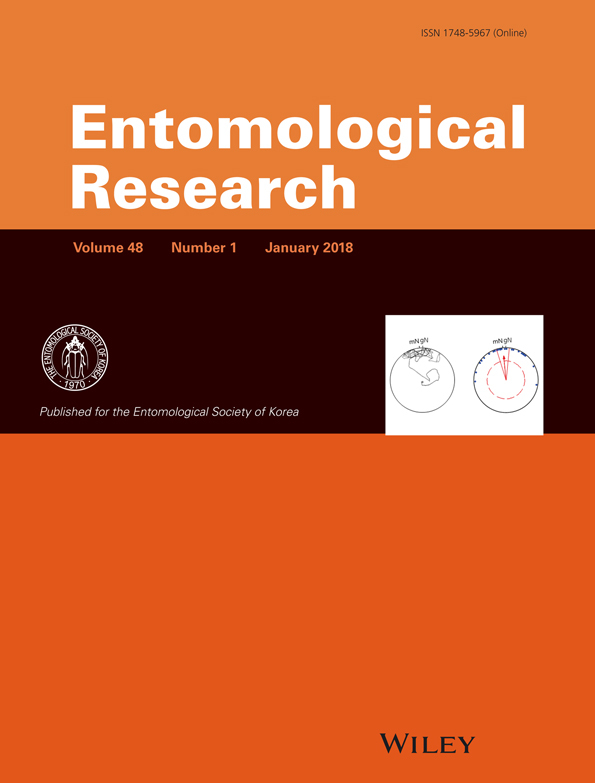Attractant effect of citral on Platypus koryoensis (Coleoptera: Curculionidae)
Abstract
An environmentally friendly control strategy for the ambrosia beetle Platypus koryoensis (Murayama), a vector of oak wilt disease, was investigated using the citral as a pheromone component. To develop an effective attractant trap, a semi-field experiment (Yeoju) and a field experiment (Gunpo) were performed. Different ratios of four different attractant mixtures (ethanol 100 %, ethanol + citral (90:10, 95:5), ethanol + citral + hexane extract of Quercus mongolica (90:5:5)) were investigated to determine their effects on P. koryoensis. The 95:5 mixture of ethanol + citral had the greatest attractant effect on P. koryoensis. However, other ambrosia beetle species did not exhibit a specific response to citral. Our findings indicate that the pheromone citral was effective at attracting P. koryoensis and that certain concentrations of citral could be used to develop an effective and environmentally friendly control agent.
Introduction
Oak wilt disease has been a subject of concern in Korea since it was first implicated in the death of an oak tree in Seongnam, Gyeonggi Province, in 2004 (KFRI 2010, 2013). The ambrosia beetle Platypus koryoensis (Coleoptera: Curculionidae) is known to facilitate oak wilt disease, and it is distributed in Korea as well as in the Far East region, such as in northeast China and Russia (KFRI 2013). P. koryoensis causes oak wilt through the mediator Raffaelea quercus-mongolicae, which is a symbiotic fungus (Hong et al. 2006; Kim et al. 2009b; KFRI 2010, 2013). Removing dead wood, implementing sticky roll traps, inducing tree defenses, and spraying pesticides are used as control methods for P. koryoensis (KFS 2014; Son et al. 2014). The primary method of controlling oak wilt includes harvesting and fumigating the infected trees using metham sodium. However, environmentally friendly control methods are needed because synthetic pesticides are toxic to humans, and they can reduce the number of natural enemies and lead to the development of resistance and environmental pollution (KFRI 2013).
The development of traps using pheromones may represent an alternative eco-friendly control method. Nerol, geraniol, neral, and geranial from P. koryoensis males induce strong responses in females according to EAG (electroantennogram) activity assays, indicating that these substances act as male pheromones (Kim et al. 2009a). Neral and geranial are the Z-form (neral) and E-form (geranial) isomers of citral, and they induce pheromonal effects in insects (Robacker & Hendry 1977; Kuwahara et al. 1983). Many studies on attractants have shown that ethanol is particularly effective in ambrosia beetles (Kelsey, 1994; Ueda et al. 2000; Miller & Rabaglia 2009; Son et al. 2015).
Therefore, this study investigated the effects of ethanol, citral, and Quercus mongolica extract as attractants for use in eco-friendly traps designed to control P. koryoensis.
Materials and Methods
Attractants
Four attractant mixtures (ethanol 100 %, ethanol + citral at 90:10 and 95:5, and ethanol + citral + the hexane extract of Quercus mongolica (90:5:5)) were used. Citral (Sigma Aldrich, St. Louis, MO) was generated from a mixture of neral and geranial (Fig. 1). The content of citral was analyzed via gas chromatography (GC; 7890A, Agilent Technology, Santa Clara, CA, USA) and GC–MS (GC-mass spectrometry, 5975C Agilent Technology) (Fig. 2). A DB-1 column was used (ID 0.25 mm × 30 m length), and the carrier gas was helium (1 mL/min). The oven temperature was 50°C to 270°C (20°C/min), and the detector temperature was 250°C.
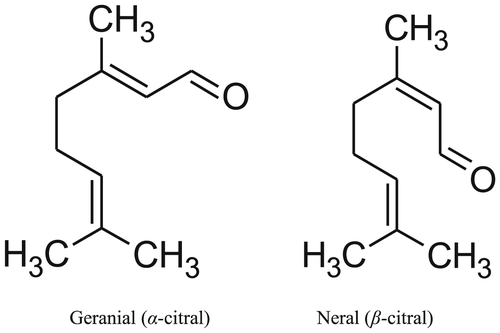
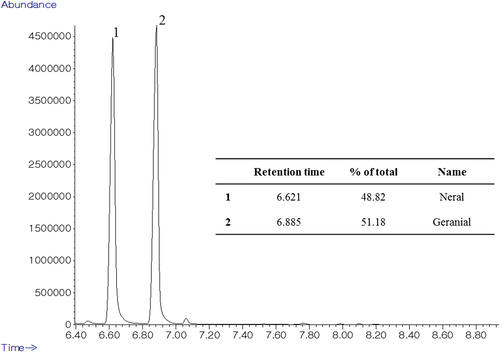
The Q. mongolica extract was extracted with hexane and then concentrated under vacuum. Briefly, 100 g of the bark of Q. mongolica was ground and immersed in 2 L of hexane. After 2 days in dark conditions, the mixture was filtered under reduced pressure using filter paper. The filtrate was concentrated in a vacuum at 37°C using a rotary vacuum concentrator (Heidolph Instruments 4000, Schwabach, Germany), and this procedure was repeated three times. The final yield was 0.764 %.
Semi-field experiment
Infected trees associated with P. koryoensis in Yeoju, Korea, were surrounded with a net (3 m × 5 m × 2 m height) from June 3 to July 20, 2016. The number of attracted P. koryoensis was investigated for each of the four attractant traps. Each trap (Green Agro Tech, Korea) was installed at the four corners at a height of 1 m above the ground, and the bottom of the net was covered with vinyl to prevent insect invasion and escape. A wire net was installed around the net to prevent damage to the net by animals. The traps were installed at six locations, and each treatment area was separated by 30 m or more. The number of P. koryoensis attracted to the treatments was examined four times.
Field experiment
A field experiment was conducted at Gunpo, Korea (June 1 to June 28, 2016) at three locations. Traps were installed at a height of approximately 1.0 m above the ground, and the traps were separated by more than 30 m. The arrangement of the four traps did not overlap, and they were installed in areas with dense oak tree growth. The trap was covered with film to prevent the intrusion of rainwater.
Statistical analysis
The attractiveness of each attractant trap for each ambrosia beetle species was compared based on ethanol 100 %.
The average number of captured ambrosia beetles were compared and analyzed by Tukey's studentized range (SAS Institute 2004).
Results
Semi-field experiment
To investigate the effect of the attractants on P. koryoensis, semi-field experiments were conducted in the Yeoju area. The number of ambrosia beetle species that were caught on trees infected by oak wilt disease during the experimental period was compared (Fig. 3). The largest number of P. koryoensis was collected on June 13, and the number of P. koryoensis attracted to the treatments decreased over time. However, the number of Xylosandrus crassiusculus ambrosia beetles attracted to the treatments increased again after July 20.
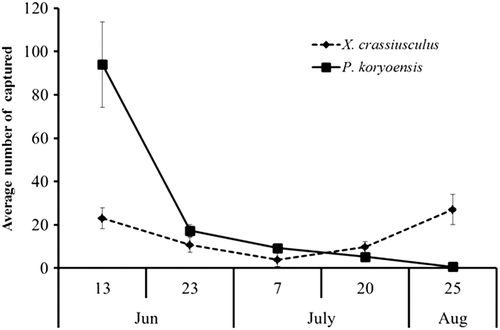
The highest relative attractiveness (RA) of P. koryoensis was observed in the treatment with the attractant ethanol + citral (95:5). However, X. crassiusculus showed the highest RA in the 100 % ethanol treatment, and the other traps were relatively less attractive (Table 1).
| Attractant content | Platypus koryoensis | Xylosandrus crassiusculus | ||
|---|---|---|---|---|
| Number of collected (mean ± SE) | RA† | Number of collected (mean ± SE) | RA | |
| E (100)‡ | 20.3 ± 1.56b | 1 | 19.0 ± 4.12a | 1 |
| E + C (90:10) | 19.3 ± 2.69b | 0.95 | 8.5 ± 1.50c | 0.45 |
| E + C (95:5) | 36.8 ± 7.20a | 1.81 | 14.0 ± 4.85ab | 0.74 |
| E + C + H (90:5:5) | 27.3 ± 10.80ab | 1.34 | 13.8 ± 4.96b | 0.73 |
| P value | 0.2626 | 0.3241 | ||
- † RA indicates relative attractiveness, Total number of each ambrosia beetle captured in each trap / total number of each ambrosia beetle captured in ethanol 100 % traps.
- ‡ E, 100 % ethanol; C, citral; H, hexane extract of Quercus mongolica.
Platypus koryoensis was largely attracted to traps containing ethanol + citral (95:5) and ethanol + citral + Quercus bark extract (Fig. 4). However, ethanol + citral (90:10) and 100 % ethanol showed little difference and attracted relatively few P. koryoensis.
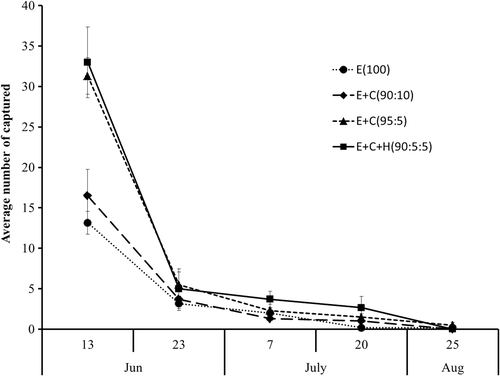
Field experiment
A variety of ambrosia beetle species were collected in the field experiment on P. koryoensis attraction in Gunpo, Gyeonggi Province. This area is affected by oak wilt disease, and P. koryoensis was the most captured beetle species. P. koryoensis showed a large fluctuation of captured density with time. However, Xyleborus mutilatus was most common in early June, and significant differences were not observed in the number of trapped X. crassiusculus, X. mutilatus, and Ambrosiodmus lewisi after mid-June, although a difference was observed in the number of captured P. koryoensis (Fig. 5). Although the largest number of P. koryoensis was captured during the experimental period, the number of attracted individuals decreased sharply in the other three ambrosia beetle species over time.
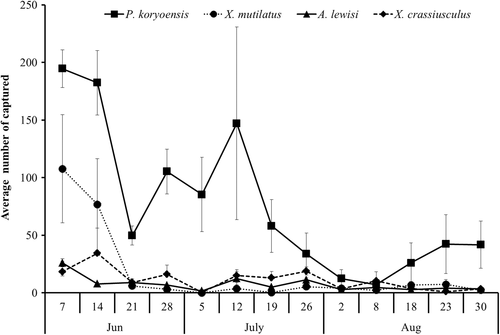
Platypus koryoensis showed the highest induction effect at a ratio of 95:5 ethanol:citral (Table 2). In the other three ambrosia beetle species, significant differences were not observed in the attraction effect according to the attractants.
| Attractant content | Platypus koryoensis | Xyleborus mutilatus | Ambrosiodmus Lewisi | Xylosandrus crassiusculus | ||||
|---|---|---|---|---|---|---|---|---|
| Number of collected (mean ± SE) | RA† | Number of collected (mean ± SE) | RA | Number of collected (mean ± SE) | RA | Number of collected (mean ± SE) | RA | |
| E (100)‡ | 91.7 ± 39.73c | 1 | 83.7 ± 39.76a | 1 | 26.7 ± 6.01a | 1 | 45.0 ± 11.36ab | 1 |
| E + C (90:10) | 78.3 ± 65.33c | 0.86 | 30.0 ± 10.02b | 0.36 | 21.0 ± 5.86a | 0.79 | 20.7 ± 14.77b | 0.46 |
| E + C (95:5) | 618.0 ± 265.50a | 6.74 | 55.3 ± 38.34ab | 0.66 | 24.0 ± 9.07a | 0.90 | 28.7 ± 13.28ab | 0.64 |
| E + C + H (90:5:5) | 197.3 ± 54.30b | 2.15 | 54.0 ± 18.90ab | 0.65 | 24.3 ± 3.84a | 0.91 | 48.7 ± 26.86a | 1.08 |
| P value | 0.0816 | 0.6625 | 0.9403 | 0.6516 | ||||
- † RA indicates relative attractiveness, Total number of each ambrosia beetle captured in each trap / total number of each ambrosia beetle captured in ethanol 100 % traps.
- ‡ E, 100 % ethanol; C, citral; H, hexane extract of Quercus mongolica.
The attractant effect for P. koryoensis was the highest at the ethanol:citral ratio of 95:5, and capture peaks occurred on June 7 and July 12, 2016 (Fig. 6). The attractant effect of the other treatments was similar, and they only attracted a small number of P. koryoensis.
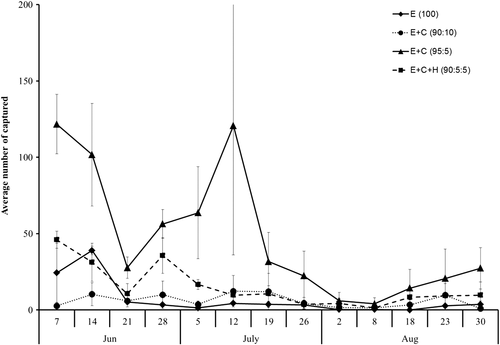
Discussion
A number of studies have shown that treatments with 100 % ethanol attract the greatest number of P. koryoensis (Son et al. 2015). However, in this study, a high number of P. koryoensis were attracted to traps containing citral, a pheromone component of P. koryoensis. The discrepancy in test results may be related to the lack of pheromone concentration tests in previous studies. Moreover, in this experiment, significant differences were not observed between 100 % ethanol and the ethanol:citral ratio of 90:10. At the ethanol:citral ratio of 95:5, an increased number of P. koryoensis were captured.
The same results were obtained in the Yeoju area, where the semi-field experiment was conducted. In the early phase of the experiment, a large number of P. koryoensis were collected, although the number of captured P. koryoensis decreased over time, which was likely because the infected tree was only introduced to the limited space of the semi-field experiment once. A comparison of the effect of the attractants on X. crassiusculus and P. koryoensis showed that the trap with 100 % ethanol had the highest attractant effect on X. crassiusculus, whereas the trap that included the pheromone citral had the highest attractant effect on P. koryoensis. Thus, adding a certain amount of citral acts as a pheromone and promotes the attractant effect on P. koryoensis. A number of other studies on ambrosia beetles have also shown that the addition of pheromones or plant-derived materials (such as α-pinene or turpentine) to ethanol results in a higher attractant effect (Montgomery & Wargo 1983; Phillips et al. 1988; Miller & Rabaglia 2009; Johnson et al. 2014).
A field experiment was conducted in Gunpo, which has a problem with oak wilt disease. In this location, P. koryoensis was most strongly attracted to the ethanol + citral (95:5) traps. The P. koryoensis adults generally show the highest density from the end of May to the middle of June as the peak season. However, on June 21, the number of the P. koryoensis collected in the traps decreased sharply, which may have been caused by the weather conditions because these data fell within the rainy season. Nevertheless, among the observed ambrosia beetle species, P. koryoensis was collected at the highest frequency. Due to the characteristics of the oak wilt disease infected area, P. koryoensis show higher density than other species. However, differences were not observed among the numbers of trapped X. crassiusculus, X. mutilatus, and Ambrosiodmus, indicating that citral acts as a P. koryoensis pheromone and has a species-specific attractant effect.
Ambrosia beetles are generally known to react to 100 % ethanol; however, the results of this experiment showed that although 100 % ethanol acted as an attractant, the effect was not stronger than that of the other traps (Moeck 1970; Ueda et al. 2000; Miller & Rabaglia 2009; Ranger et al. 2011). P. koryoensis was observed to react specifically to citral, and the concentration of citral was a factor that influenced the attractant effect. In the future, additional experiments should be performed to determine the optimal citral concentration for P. koryoensis.
The results of this study have provided helpful insights for the development of an effective and environmentally friendly method that incorporates citral for the control of P. koryoensis, which causes oak wilt disease.
Acknowledgment
This study was supported by the Korea Forest Research Institute General Research Project.



